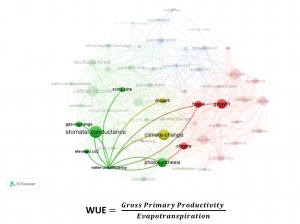Thinning is the main forestry measure to increase tree growth by reducing stand tree density and competition for resources, especially in water-limited regions. In order to better understand and model the interaction between forest carbon and water after thinning at forest stand level, a meta-analysis using VOSviwer based on 825 publications from 1990 to 2018 is conducted, revealing three main distinct clusters of related terms in research linked to the forest stand density and water use efficiency (WUE), forest growth and competition, climate change and use efficiency.
Enlarge

WUE is affected by forest management, forest disturbance, and climate change. Most studies suggest that WUE is increased and rainfall dependence is decreased after thinning to mitigate growth reductions during drought. A review of different forest carbon and water models at stand level is conducted including statistical models and hybrid models. The major driving functions, the simulation of different thinning seniors, special features and limitation are identified. Finally, the various data sources that are currently available to validate existing models are discussed. Future research will be conducted based on the selected model at the lodgepole pine forest stand in upper Penticton watershed.


 Follow
Follow